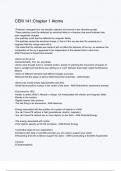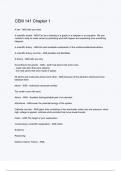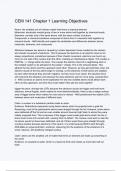Cem 141 chapter 1 - Study guides, Class notes & Summaries
Looking for the best study guides, study notes and summaries about Cem 141 chapter 1? On this page you'll find 15 study documents about Cem 141 chapter 1.
All 15 results
Sort by
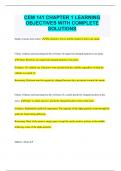
-
CEM 141 CHAPTER 1 LEARNING OBJECTIVES WITH COMPLETE SOLUTIONS
- Exam (elaborations) • 6 pages • 2024
- Available in package deal
-
- $9.99
- + learn more
CEM 141 CHAPTER 1 LEARNING OBJECTIVES WITH COMPLETE SOLUTIONS Stable systems form when? The attractive forces and the repulsive forces are equal. Claim, evidence and reasoning for the existence of negatively charged particles in an atom. Claim: Electron's are negatively charged particles of an atom. Evidence: JJ's cathode ray. Electron's were ejected from the cathode, regardless of what the cathode was made of. Reasoning: Electrons must be negatively charged because they acceler...
CEM 141 Chapter 1 Atoms Questions And Answers Rated A+ New Update Assured Satisfaction
CEM 141 Chapter 1 Questions And Answers Rated A+ New Update Assured Satisfaction
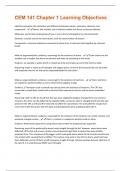
-
CEM 141 Chapter 1 Learning Objectives Questions with well explained answers
- Exam (elaborations) • 3 pages • 2024
- Available in package deal
-
- $7.99
- + learn more
Identify and explain the similarities and differences between atoms, molecules, elements, and compounds - Atoms: the smallest unit of ordinary matter that forms a chemical element Molecules: electrically neutral group of two or more atoms held together by chemical bonds. Elements: consists only of the same atoms, with the same number of protons Compounds: a chemical substance composed of atoms from 2+ elements held together by chemical bonds Make an argument(claim, evidence, reasoning) for...
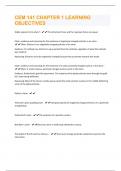
-
CEM 141 CHAPTER 1 LEARNING OBJECTIVES QUESTIONS WITH A GUARANTEED A+
- Exam (elaborations) • 4 pages • 2023
- Available in package deal
-
- $7.19
- + learn more
Stable systems form when? - The attractive forces and the repulsive forces are equal. Claim, evidence and reasoning for the existence of negatively charged particles in an atom. - Claim: Electron's are negatively charged particles of an atom. Evidence: JJ's cathode ray. Electron's were ejected from the cathode, regardless of what the cathode was made of. Reasoning: Electrons must be negatively charged because they accelerate towards the anode. Claim, evidence and reasoning for the exist...
CEM 141 Chapter 1 Learning Objectives Questions And Answers Rated A+ New Update Assured Satisfaction
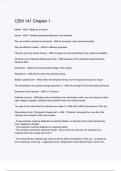
-
CEM 141 Chapter 1 (1).
- Exam (elaborations) • 4 pages • 2024
- Available in package deal
-
- $7.99
- + learn more
CEM 141 Chapter 1 (1).
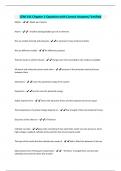
-
CEM 141 Chapter 1-Question with Correct Answers/ Verified
- Exam (elaborations) • 5 pages • 2024
-
- $10.49
- + learn more
Matter -️️- Made up of atoms Atoms -️️- Smallest distinguishable part of an element. We use models (mental and physical) -️️to represent many chemical entities We use different models -️️for different purposes Theories (such as atomic theory) -️️change over time according to the evidence available. All atoms and molecules attract each other -️️because of the attractive electrical forces between them Attractions -️️lower the potential energy of the system
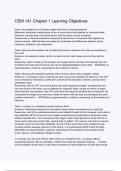
-
CEM 141 Chapter 1 Learning Objectives (1)
- Exam (elaborations) • 3 pages • 2024
- Available in package deal
-
- $7.99
- + learn more
CEM 141 Chapter 1 Learning Objectives (1)
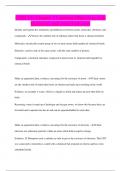
-
CEM 141 Chapter 1 Learning Objectives with Questions and correct answers
- Exam (elaborations) • 5 pages • 2024
-
- $7.99
- + learn more
Identify and explain the similarities and differences between atoms, molecules, elements, and compounds - Atoms: the smallest unit of ordinary matter that forms a chemical element Molecules: electrically neutral group of two or more atoms held together by chemical bonds. Elements: consists only of the same atoms, with the same number of protons Compounds: a chemical substance composed of atoms from 2+ elements held together by chemical bonds Make an argument(claim, evidence, reasoning) for...

$6.50 for your textbook summary multiplied by 100 fellow students... Do the math: that's a lot of money! Don't be a thief of your own wallet and start uploading yours now. Discover all about earning on Stuvia

